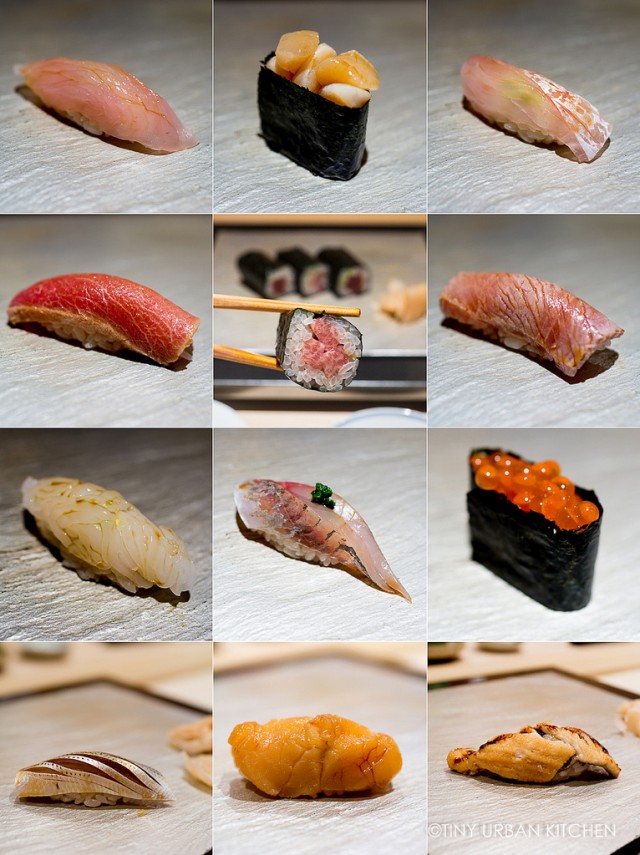
This is the third post in the Tokyo - Kyoto - Osaka series. Other posts in this series include Matsugen (delicious soba) and the intro post: Tokyo, Kyoto, and Osaka.
A popular first thing to do in Tokyo following a long, tiring flight is, surprisingly, to get up at 4AM the next morning to visit the daily auction at the world famous Tsukiji Fish Market.
The rationale goes like this: since you're super jet-lagged anyway upon arriving in Japan, why not take this opportunity to visit the one place where you have to be up at a crazy hour anyway?
I had the same thought.
After all, in the past several visits to Tokyo, I never saw the live auction at Tsukiji. I came close - once - with my mom and sister when I was still in high school. We just missed the actual auction, though we did manage to see up close and personal huge whole tuna fish, vendors cutting up ultra fresh sashimi, and all those interesting wheeled vehicles full of seafood roaming around.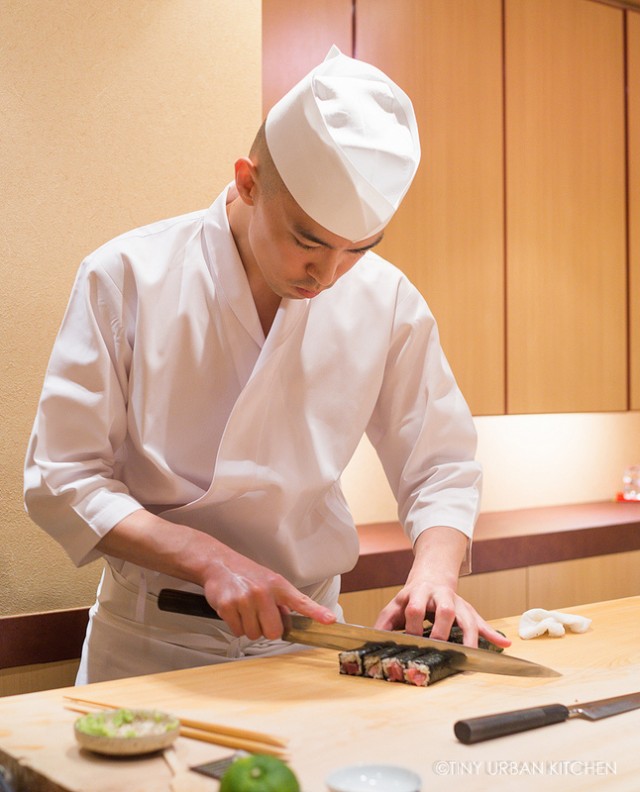
Unfortunately, it's getting harder and harder to see the live auction. The influx of tourists made the crowds so unwieldy, there is now a hard limit to the number of tourists who can enter per day. Only 60 people can enter the space at once, in two waves: one at 5:25 AM, and one at 5:50AM. It's first come first serve, so there's a chance you could get up super early, stand in line, and still not be able to enter.
Furthermore, they are renovating and expanding the entire market, so the historic, crowded, crazy market as we know it today will soon cease to exist.
Despite all those reasons to visit now, we still ended up not going. After a long flight from the U.S., it's exhausting to imagine just sleeping a few hours before getting up again super early to watch the auction. We were all starting to get sick and didn't want the lack of sleep to incapacitate us for the entire trip. Plus, the risk of potentially getting up early and still missing the auction would just be too, too disappointing.
So we chose not to go.
Someday. I swear, someday I will make it out there.
At least, as a consolation prize of sorts, we were still able to enjoy the fruits of the market.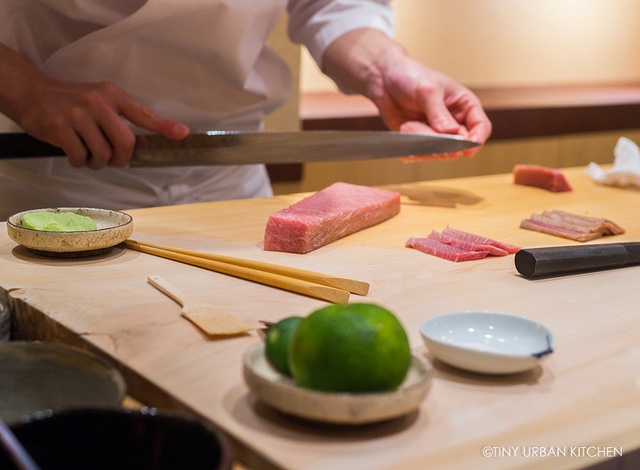
After visiting the market in Tsukiji, most tourists eat "sushi breakfast" at one of the many sushi restaurants nearby. The most popular places have insanely long lines (2-3 hours is not uncommon). The fish is fresh and the prices are good, but you do pay for it by standing in line for hours.
A sushi breakfast at one of these places will run you around 3800 yen ($38 USD), a pretty good price considering the freshness and quality of the fish. Don't be fooled into thinking this is the best sushi you can find in Tokyo, though. It's decent, but it's not even close to the best.
For much higher quality sushi, consider heading down a few blocks to a place like Sushi Iwa (one Michelin star), where sushi lunch starts at 4750 yen (a mere $10 USD more), there's no multi-hour wait in line, and you can eat at a reasonable time.
We had a fantastic lunch here. It was nice being able to sleep in, get well-rested, and then leisurely show up for our 11:30AM lunch reservation.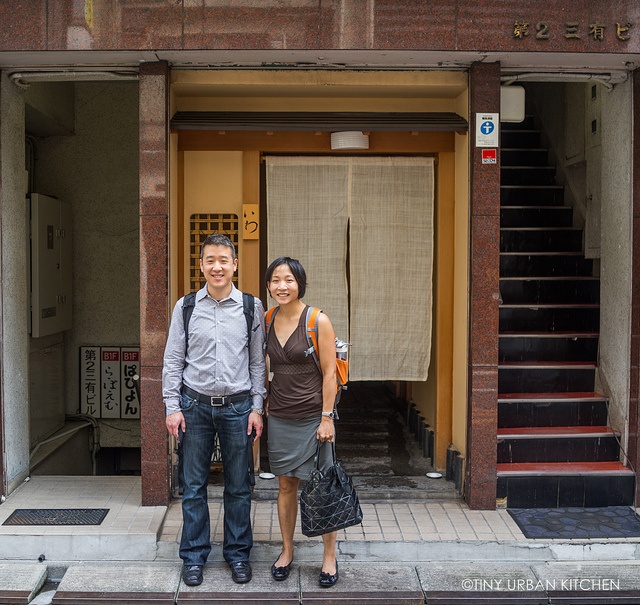
Sushi Iwa is tinywith only six counter seats. I was surprised I was able to make a reservation with relative ease, booking a mere two weeks before my arrival.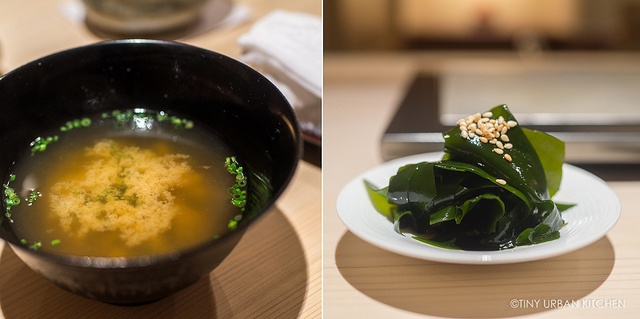
Not all sushi places will do this, but Sushi Iwa gives you wakame (kelp) to munch on as well as hot miso soup.
For lunch, the chef gave us a choice of 10 pieces or 13 pieces. We opted for the 13-piece lunch, which cost around ¥8000 ($80). In general, lunch prices range between ¥4,725 to ¥15,750 (roughly $48 to $158), which is much cheaper than dinner ¥18,900-26,250 ($189 to $263).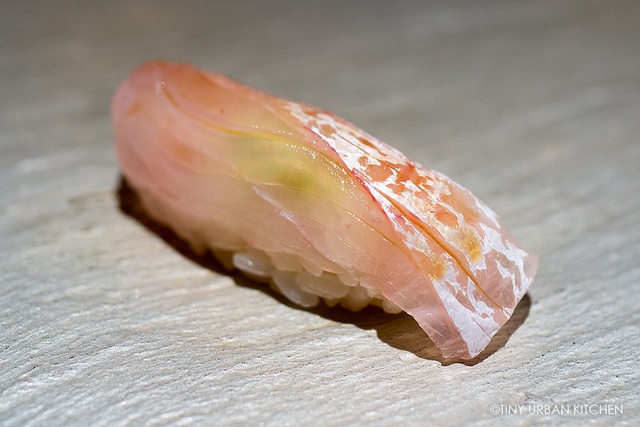
A sushi tasting usually starts with lighter, white fish, such as Tai (red snapper).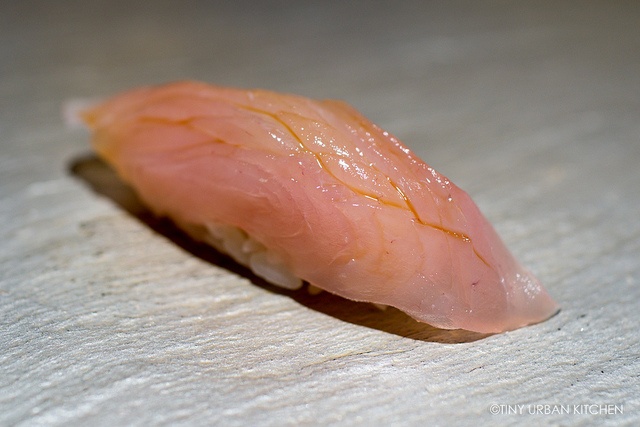 Usually, the sushi chef seasons the nigiri for you. The wasabi is nestled inside between the rice and the fish (in this case, Hirame or fluke) while the soy sauce is brushed on the outside. You don't get a separate dish of soy sauce or any dollops of wasabi for dipping.
Usually, the sushi chef seasons the nigiri for you. The wasabi is nestled inside between the rice and the fish (in this case, Hirame or fluke) while the soy sauce is brushed on the outside. You don't get a separate dish of soy sauce or any dollops of wasabi for dipping.
We also had Kampachi (amber jack), which I sadly forgot to photograph.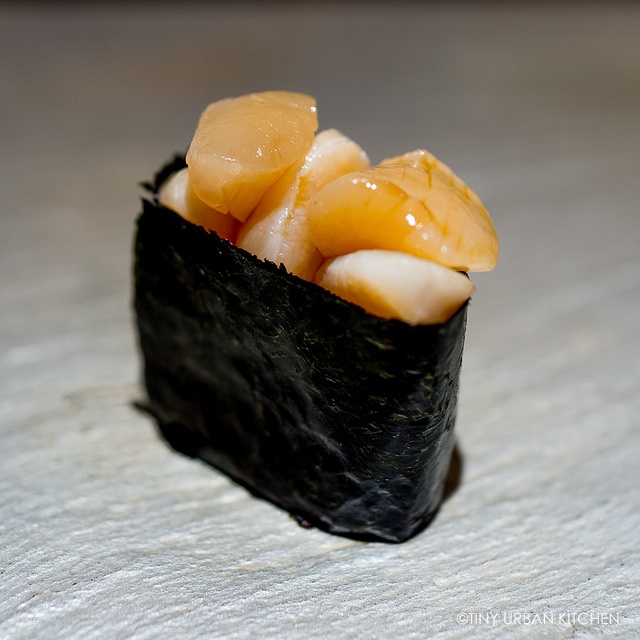
You can either eat with your hands or use chopsticks. Though most pieces are nigiri (fish on top of rice), sometimes you'll see this gunkan-style sushi (translated as "warship" sushi, invented at Kyubey!). Here is a gunkan-style Kaibashira, which translates to mean "adductor muscle of a shellfish" (tiny scallops in this case).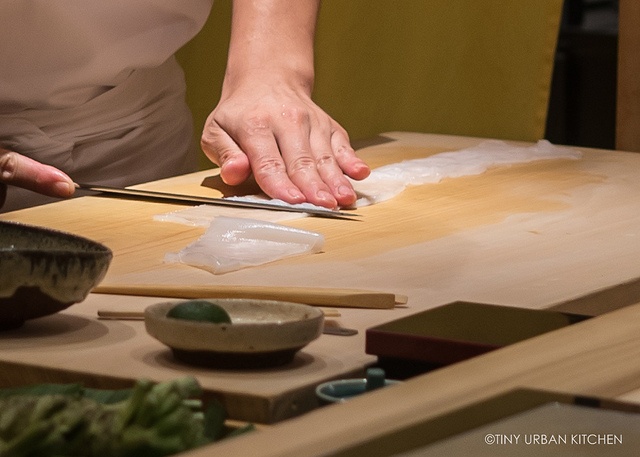
We were intrigued by the unusual preparation of Ika (squid) here. The sushi chef sliced crazy thin sheets using just his knife. He then julienned these slices some more, finally bringing it all together like this: 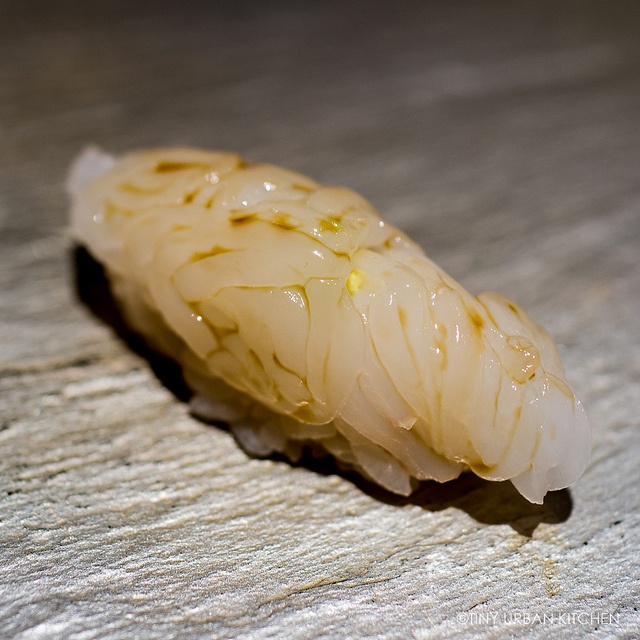 It was super tender and delicious.
It was super tender and delicious.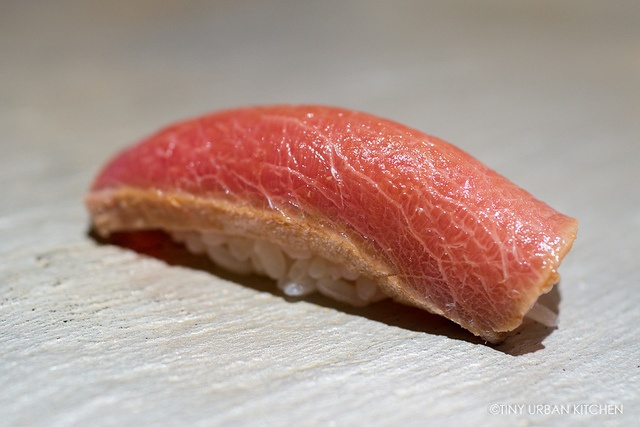 Nothing beats the tuna in Japan, called Maguro or Akami. Iwa ages all of his tuna, which results in a softer, more tender, and more deeply flavored piece of fish.
Nothing beats the tuna in Japan, called Maguro or Akami. Iwa ages all of his tuna, which results in a softer, more tender, and more deeply flavored piece of fish.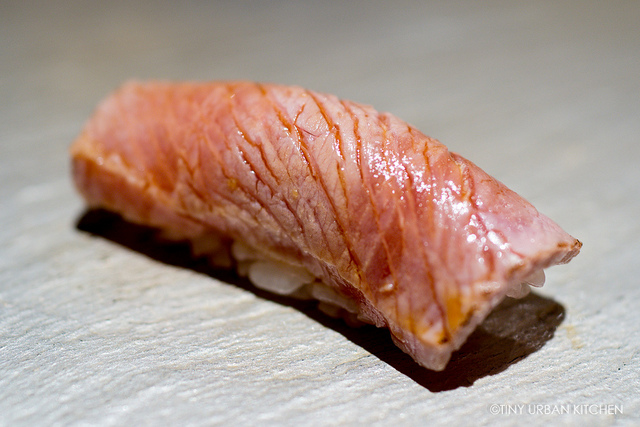 One of my favorites is seared Toro (tuna belly).
One of my favorites is seared Toro (tuna belly). 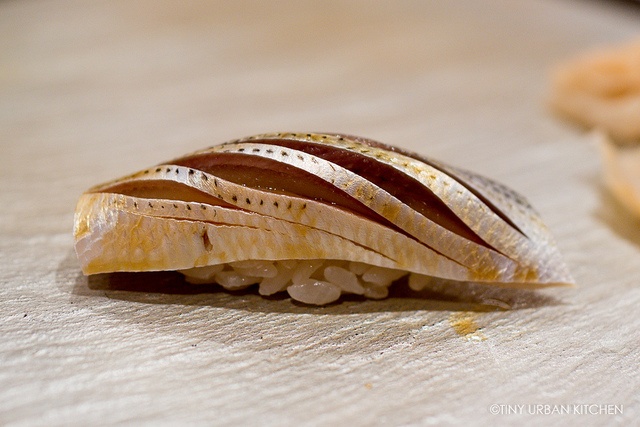
I loved the meticulous artistry that went into every piece, like the perfectly spaced cuts in this piece of Kohada (gizzard shad).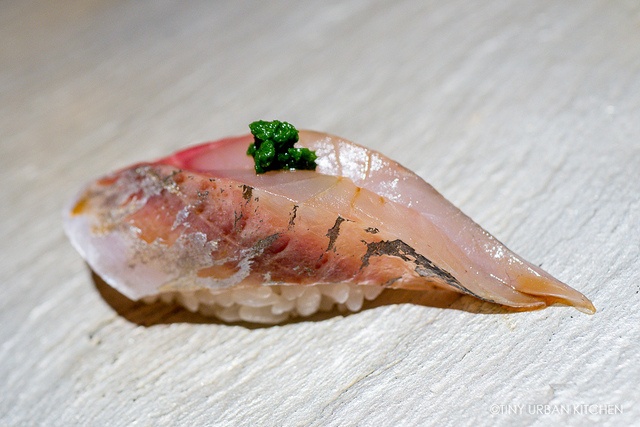 Aji (horse mackerel), came with a tiny dollop of leek "pesto" on top.
Aji (horse mackerel), came with a tiny dollop of leek "pesto" on top. Ikura (salmon roe) in Japan has absolutely no element of fishiness, and I actually enjoy it here.
Ikura (salmon roe) in Japan has absolutely no element of fishiness, and I actually enjoy it here.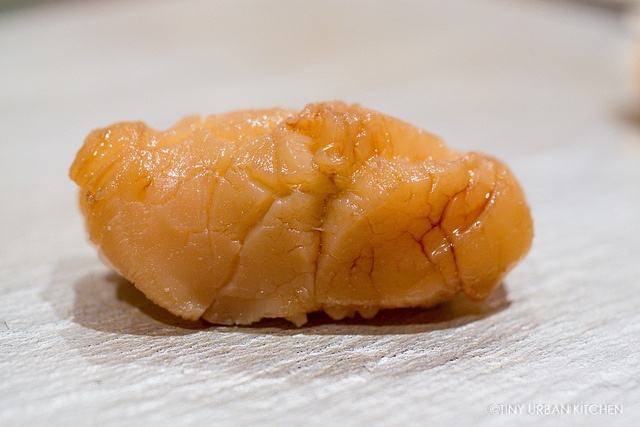 Here is a much larger scallop, called Hotate.
Here is a much larger scallop, called Hotate.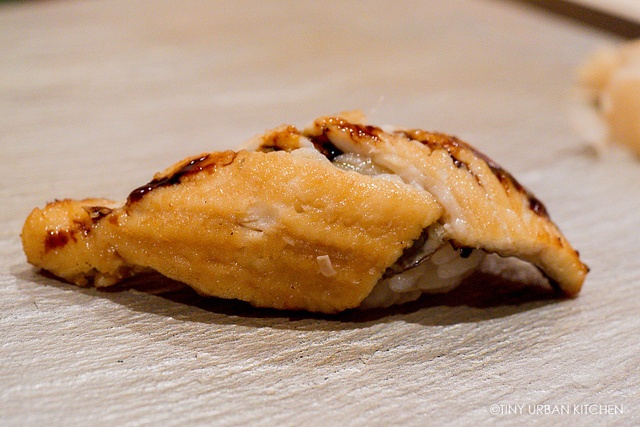
True practitioners of Edo-style sushi (serving only seafood that comes out of Tokyo Bay) will only serve Anago (saltwater eel) and never Unagi (freshwater eel). I actually prefer Anago, which I find to be sweeter, more tender, and a bit lighter in flavor. Lime is a common 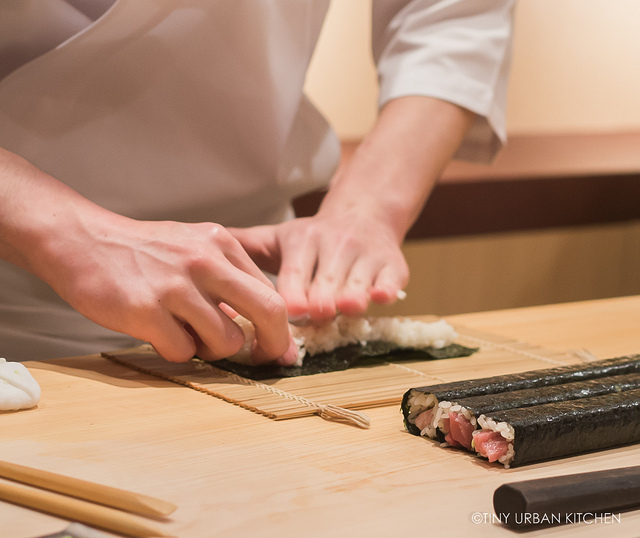 At the end of most sushi meals, the chef will make a maki roll.
At the end of most sushi meals, the chef will make a maki roll. 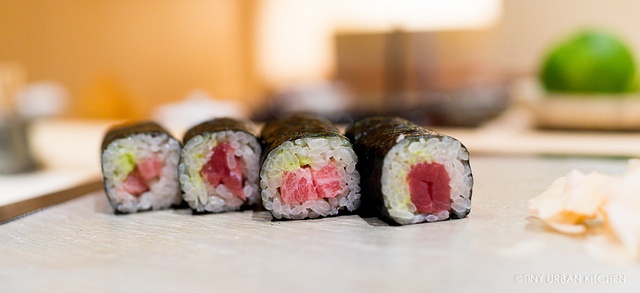
Here, the chef makes a maki with Toro (tuna belly) and Maguro (tuna).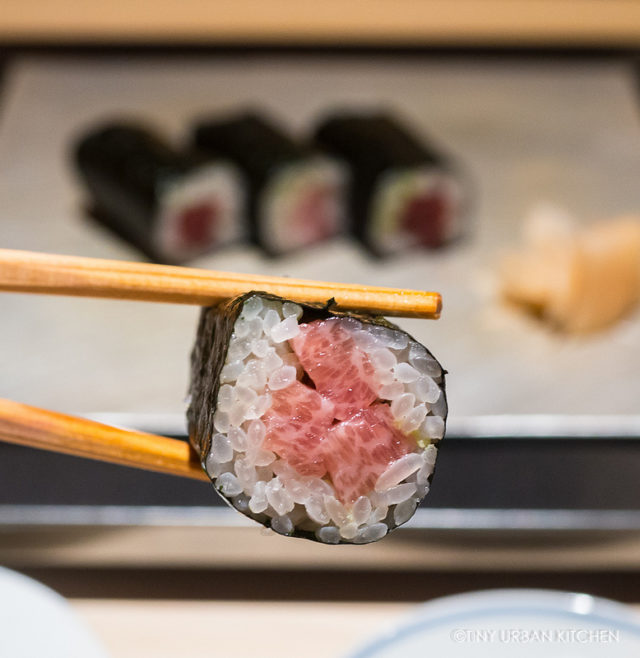
Isn't that absolutely beautiful?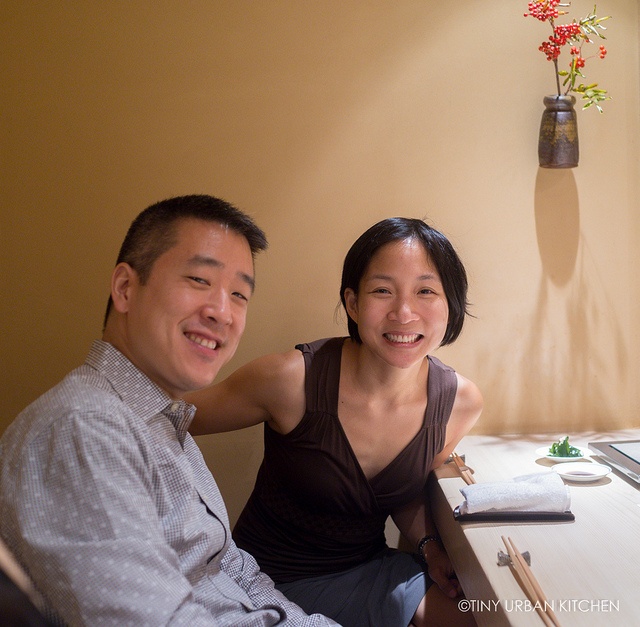
It was a great first sushi meal in Japan. We had allowed ourselves to sleep a solid 9-10 hours after crashing the night before (following our reasonably light Matsugen soba meal). It was nice to roam around Ginza just briefly before our 11:30 AM reservation (though it also surprised us that most department stores in Ginza do not open intil 11AM! - late culture!).
The food is very good here. It doesn't quite reach the ultimate perfection of the top sushi places we've visited, such as Sukiyabashi Jiro, Sushi Mizutani, or Sushi Sawada. However, it was significantly better than the sushi we've had at Tsujiki Fish Market (though, to be fair, we've never lined up at the two most popular places).
Like most sushi restaurants in Japan, this one has no English signs out front, so you'll have to look for the Japanese characters (see sign below). Thankfully, this restaurant faces the street (unlike many that are either in basements or in highrises), so it's a bit easier to find the sign!
Sushi Iwa
8-5-25 Ginza, Chuo-ku
Tokyo, Japan
Tel: 03-3572-0955
Related Posts
Japan Eating Guide
Kyubey
Sukiyabashi Jiro
Sushi Mizutani
Sushi Sawada
Sushi Kanesaka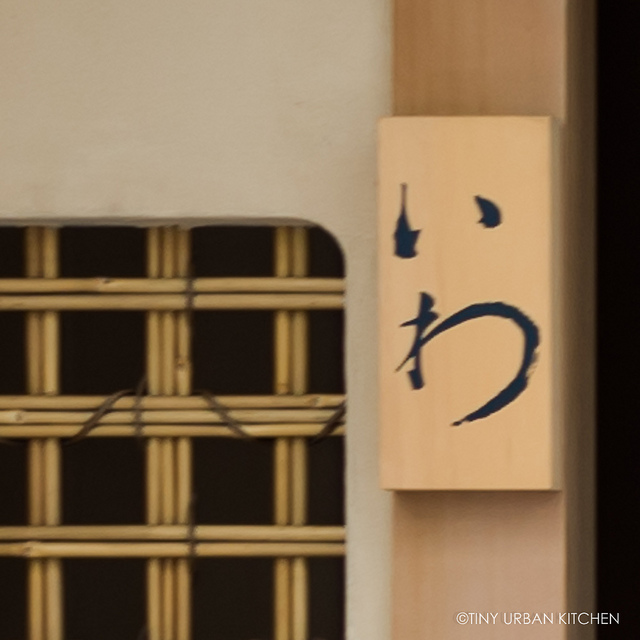
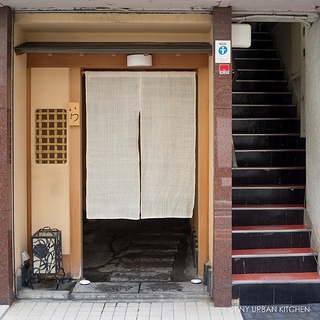
All Rights Reserved

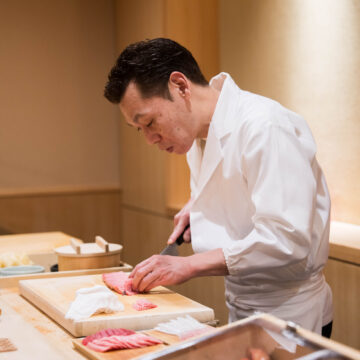

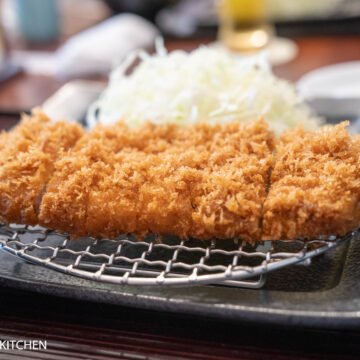
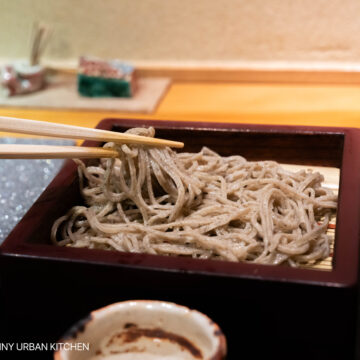
[…] Wadatsumi began as the second location of Tokyo’s Sushi Iwa, a highly regarded edomae sushiya in Tokyo. Originally called Ginza Iwa when it opened in 2013, it […]